By Jim Moore

The action may be animated, but the production team behind Disney’s new film Planes 2: Fire and Rescue, sequel to the 2013 animated feature Planes, strove to keep every detail as realistic as possible.
Great pains were taken to avoid mistakes, such as propellers turning in the wrong direction or aircraft doing things that are simply impossible, and to get the details right when portraying how a range of firefighting aircraft perform in the air. Consulting with professional pilots and firefighters, Disney worked to craft characters that, aside from being talking airplanes and helicopters, behave as their real-life counterparts do, down to the aerodynamics and radio phraseology. “It has to be a believable world,” said Bob Gannaway, the film’s director. “Then, you will hopefully forget that it’s animated, and just get into the story.”
The story began coming together while the first Planes was still in production, and Gannaway set out in search of a new mission for Dusty Crophopper, the central character of both films (voiced by actor Dane Cook). Once Gannaway learned that agricultural aircraft are also used for aerial firefighting, it was time to learn how it is done in real life.
The California Department of Forestry and Fire Protection—Cal Fire—responded with enthusiasm when Gannaway and producer Ferrell Barron reached out seeking help. The real-life firefighters who specialize in backcountry fire suppression invited the movie crew to tour firefighting bases and observe training exercises. Barron said Cal Fire Battalion Chief Travis Alexander was involved throughout the four-year effort to make the film. Alexander and others on the Cal Fire staff coordinated numerous meetings with pilots, smoke jumpers, and others on the firefighting team. With helicopters added to the cast of characters, the producers also enlisted renowned aerobatic helicopter pilot Chuck Aaron, known for demonstrating a wide range of highly unusual attitudes in Red Bull colors.
While animated films typically are made with younger audiences in mind, both producer and director said they were gratified that early screenings for Cal Fire staff (and families) drew an enthusiastic response.
“We want aviators to enjoy the film and be excited that it is accurate,” Gannaway said. “The second thing is we want the firefighters to watch the movie and also say that they got it right—or if we cheated a little bit, they understand why.”
Email [email protected]
Tell all
Director Bob Gannaway confessed there is one particular scene In Planes 2 where they did have to “cheat” a little bit, although he was coy about which particular laws of physics may have been infringed upon. He said aviators should not have trouble spotting it, and there was no getting around it, either.
They gave it a lot of thought, and decided in the end that the needs of the story trumped the need for realism—just once. “I’m hoping that I got one get-out-of-jail card,” Gannaway said.
News
FAA to evaluate nine unleaded fuels
Possible avgas replacements proposed
By Dave Hirschman
The search for an unleaded fuel to replace avgas moved forward as the FAA received nine proposals for its Piston Aviation Fuels Initiative (PAFI) by the July 1 deadline.
The formal submissions came from fuel producers Afton Chemical Company, Avgas LLC, Shell, Swift Fuels, and a consortium made up of BP, TOTAL, and Hjelmco.
“Aviation organizations, the petroleum industry, and the FAA are working collaboratively to ensure the aviation community will have access to unleaded fuel that meets performance and safety standards, is affordable, and can be used by the existing fleet with minimal disruption,” said AOPA President Mark Baker. “We are pleased with the progress so far and look forward to the next phase.”
PAFI is an industry-government effort to develop and deploy a safe, new unleaded avgas for the piston-engine aircraft fleet. In addition to AOPA and the FAA, the PAFI Steering Group includes the American Petroleum Institute, the Experimental Aircraft Association, the General Aviation Manufacturers Association, the National Air Transportation Association, and the National Business Aviation Association.
The FAA will now begin assessing the candidate fuels based on safety, costs, production and distribution, and environmental impact.
The most promising fuels will undergo laboratory testing led by the FAA’s William J. Hughes Technical Center beginning in September. Fuel developers will each be asked to supply 100 gallons of fuel for phase one testing. Fuels that are determined to be potentially viable replacements in this evaluation will move to phase two, which is comprised of full-scale engine and aircraft testing. This will require 10,000 gallons of fuel from each developer and will generate standardized performance data necessary to demonstrate scalability of production, and support qualification and fleet-wide certification data.
Congress fully supports this program and its goal of deploying a new unleaded replacement avgas by 2018, and provided $6 million in the current fiscal year. Both the U.S. House and Senate appropriations committees have proposed spending another $6 million on the program next year, which is $300,000 above President Obama’s request.
There are approximately 167,000 piston-engine aircraft in the United States and a total of 230,000 worldwide that primarily rely on the currently available 100LL avgas. It is the only remaining transportation fuel in the United States that contains added tetraethyl lead.
Email [email protected]
75 years ago this month
AOPA was founded May 15, 1939.
It is September 1939. Germany and the Soviet Union invade Poland. The United Kingdom, France, New Zealand, Australia, South Africa, and Canada declare war on Germany. World War II has begun.
September 1
The German Luftwaffe uses 1,600 of its 3,650 combat aircraft in the invasion of Poland. J. Robert Oppenheimer publishes a previously rejected paper on black holes in Physical Review. He later leads the team that explodes the first atomic bomb. Gen. George Marshall is sworn in as United States Army chief of staff. BBC television ceases broadcasting after a Mickey Mouse cartoon, fearing German bombers could track the signals to London.
September 2
The Luftwaffe achieves air superiority over Poland.
Jackie Cochran, a New York City beautician and winner of transcontinental air races, writes Eleanor Roosevelt suggesting valuable contributions could be made by a women’s air corps in case of war.
September 3
The United Kingdom and France declare war on Germany.
September 14
First tethered flight of the Sikorsky VS–300, the first helicopter to enter mass production.
September 17
The Soviet Union invades Poland. A German U-boat sinks the British aircraft carrier HMS Courageous while on antisubmarine operations, with the loss of 518 lives.
September 20
Joe Louis knocks out Bob Pastor for the heavyweight boxing title.
September 25
Nicola di Mauro of Italy sets a world seaplane altitude record of 44,429 feet in a Caproni Ca.161 Idro. Defenders of Warsaw surrender after aerial bombing witnessed by Adolf Hitler.
September 30
First televised American football game between Fordham and Waynesburg in New York City is broadcast with one camera and announcer Bill Stern to 1,000 television sets. Fordham won, 34-7.
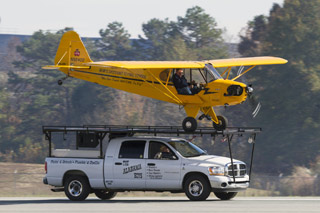
People
Top: photo courtesy Greg Koontz; bottom: Max Haynes
Greg Koontz is the 2014 winner of the Bill Barber Award for Showmanship given each year to an outstanding airshow performer. In his act, Koontz flies the American Champion Super Decathlon, the Extreme Decathlon, and a Piper Cub that is landed atop a truck. Koontz was a corporate jet pilot until 2002, when he began performing in airshows full-time and teaching courses in basic aerobatics and upset recovery for general aviation pilots at his ranch in Ashville, Alabama. Prior to his corporate jet career he performed in Ernie Moser’s Flying Circus based in St. Augustine, Florida. —AKM
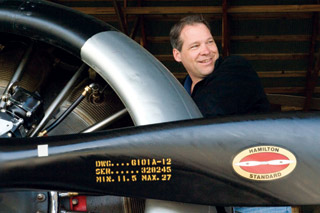 Eyes in the sky
Eyes in the sky
When your city is only 16 blocks long and 10 blocks wide, there isn’t always a choice of ophthalmologists, let alone a shopping center. But if there is an airport, such as the one at Gettysburg, South Dakota, the doctors from larger towns can still make house calls—or airport calls, in this case.
Dr. John Bormes of Aberdeen, South Dakota, routinely sees patients at offices in four small South Dakota towns thanks to his Piper Seneca III, cutting travel time in half. All four have airports immediately beside the town. Trips that are 100 or more miles by car become 60- to 80-mile jaunts by air. He travels by car to three additional offices.
Bormes also owns a 1942 Stearman PT–17 and a North American T–6. —AKM
Three amigos do Vegas
Three friends ages 70 and older mounted up in their Champ, Murphy Rebel, and amphibian Legend Cub aircraft for three weeks and three days to land in all the lower 48 United States.
Each had a nickname, says Tarry “Elder Geezer” Bolger, 78, of Palestine, Illinois. He was the oldest, beating Sam “Capt. Sam” Kelso by a few months. Kelso earned lots of hours as a corporate pilot for many of the nation’s largest corporations—enough hours to be known as “captain.” The baby of the group was Tom “Tanker Tom” Anderson, whose 44 gallons in his Murphy Rebel rescued his friends along the way, including once when an airport advertising fuel had none. A one-quart water bottle served as the fuel transfer device.
Bolger had a carburetor problem in Las Vegas and the group was forced to visit The Strip for two hours. Kelso and Anderson gambled $1 in slot machines and lost, while Bolger “invested” $1 and won $10. “Suddenly we went from Three Amigos to The Three Musketeers, and the other two wanted me to share because it was ‘All for one.’ I wouldn’t do it,” Bolger said. —AKM
Mira Slovak dies at 84
Suffering under both Nazi and Russian oppression, Mira Slovak became a Czech Airlines captain and took over one of the company’s flights in 1953 to make his escape from communism with fellow pilots who were co-conspirators. He planned to fly to London but weather there was poor. He was intercepted by two U.S. Air Force F–84 jets and escorted to their base at Frankfort, Germany. He later became a U.S. citizen.
He was an airshow pilot, a Continental Airlines pilot, a Reno winner in the top Unlimited Gold category at the 1964 National Championship Air Races, and a hydroplane race champion. Boat and plane crashes sent him to the hospital four times. At Santa Paula, California, he became the airport legend and friend of movie stars. Slovak died June 16 of stomach cancer at his home in Fallbrook, California. —AKM
Products
Fly more often, have more fun
SocialFlight has an app for that
By Dave Hirschman
 Providing new reasons to fly has been SocialFlight’s reason to exist since Jeff Simon launched the online firm two years ago, and it appears to be working.
Providing new reasons to fly has been SocialFlight’s reason to exist since Jeff Simon launched the online firm two years ago, and it appears to be working.
More than 25,000 people have signed up for the free service which includes customized weekly email listings of regional aviation events. And about 200,000 people see online SocialFlight calendars through other media.
Now, the Massachusetts firm has launched SocialFlight 4.0, a free app that provides detailed information about destinations as well as reviews of area restaurants, hotels, and attractions. The mobile app also shows current trip planning material, such as airport information and weather forecasts.
“Flying tends to be a somewhat solitary pursuit,” Simon said. “SocialFlight changes that by helping people connect around events, destinations, and shared interests.”
About 15,000 aviation events have been listed via SocialFlight in the past 18 months, and some are drawing people from far outside their usual geographic areas.
“Flying clubs and other aviation groups used to be inward-looking,” he said. “All of a sudden they are getting a lot more new people at their events, and that’s really healthy for small organizations.”
SocialFlight’s weekly list of aviation activities is distributed every Wednesday evening, and that gets pilots thinking about making plans for weekend flying. It also has the potential to reach many more aviation enthusiasts who haven’t grown up around aviation.
“We as an industry tend to do a fairly poor job of reaching people who have a desire to fly but don’t know anyone who actually does fly,” Simon said. “Things change as soon as they start to make those connections.”
SocialFlight 4.0 also includes search tools designed to form networks based on common interests. If you want to find someone living within 50 miles that owns an antique biplane and also is a flight instructor, SocialFlight can do that for you.

SocialFlight 4.0 can be found at both Apple and Google app stores.
Email [email protected]
For more information: www.socialflight.com
Intellicast app features marching ants
What makes the free Intellicast for the iPhone and Android devices and Intellicast HD for the iPad the coolest weather app at iTunes? It’s those little arrows that show wind direction. Made by WSI Corporation, it features a hoard of arrows that look like a nest of crawling ants, all marching in the direction the wind is moving. That helps to predict whether a cell will hit your area, or just brush by the edge. Radar images are fast-loading, too. —AKM
Airport Stories
Hidden gem
Airport on the edge of wilderness
By Mike Klein
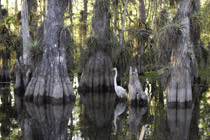 On the Gulf coast of Florida, just on the edge of the Everglades National Park, sits the first airport chartered in the state—Everglades Airpark (X01). Some visitors refer to it as the “10,000 islands outpost,” and it could certainly qualify as such.
On the Gulf coast of Florida, just on the edge of the Everglades National Park, sits the first airport chartered in the state—Everglades Airpark (X01). Some visitors refer to it as the “10,000 islands outpost,” and it could certainly qualify as such.
Everglades Airpark is on the boundary of Everglades National Park and located in Everglades City, the town built by Barron Gift Collier in 1924 as a base for construction of the Tamiami Trail. The city was the original Collier County seat and was nearly destroyed when it was inundated with 11 feet of water from Hurricane Donna in 1960.
In 1947 President Harry Truman visited to inaugurate the opening of the Everglades National Park. Many world leaders and celebrities seeking scenic serenity—for artistic production, business, or a getaway visit—have visited this historic outpost.
Everglades City is known as the Stone Crab Capitol of the World. Every year aviators and boaters arrive to take home coolers filled with this unique delicacy.
There are experiences here that you will find nowhere else: airboat tours, fishing expeditions, kayaking, and wildlife—such as alligators, manatees, birds of all species, snakes, and, yes, crocodiles. The area is truly the last of the wild, and although it does take some minimal survival skills—there are no hospitals, clinics, drug stores, traffic lights, fast food joints, taxis, golf courses, or shopping malls—a visit here will fill your camera, treat your stomach, and provide a lifetime of tales to relate.
Bicycles are available to rent at the airport for touring the mile-long, half-mile-wide city that is full of great attractions and activities. Or a phone call to any restaurant will get you a free pick-up and ride to town.
If you’re not yet ready to eat, you and your passengers could hike around the corner to the national park headquarters for a cruise through the wetlands—where you might spot a gator—or out toward the Gulf where along the way you will see dolphins, wading herons, diving cormorants, snook, and views of one of the most memorable places on Earth.
Chuck Gretzke, who operates Wings Aero Tours, flies his bush plane down from Alaska for the winter season and once a month hosts a pancake breakfast, attracting dozens of fliers in unique, antique, homebuilt, and Experimental aircraft; plus Light Sport aircraft, Beech Barons, Pilatus turboprops, and numerous large and small whirlybirds. The 2,400-foot-long runway, which drops off behind the mangroves, sometimes makes for a few go-arounds, especially if a crosswind is up, but the earlier arrivals sitting on the viewing deck will offer plenty of informed opinions on your technique. On any given day there is the chance of watching John Apte set up and pick up a banner with his Cessna 170 for his advertising routine, a demonstration of precision low-level flying and maximum climbout effort.
The FAA Safety Team frequently hosts Wings-qualified seminars on issues ranging from aircraft maintenance to wilderness survival. These are popular events, and many pilots gas up afterwards and head on down to the Florida Keys for a tour of the emerald waters of Florida Bay and the vast southern wilderness. Everglades Airpark is the last stop on the Gulf Coast before the Florida Keys and the first stop on the return. Fuel prices are generally one to two dollars per gallon less than anywhere on the Keys.
This little airport is a gem of discovery and if you visit once you’ll surely want to return often with friends and family—or keep as your personal escape site.
Mike Klein, AOPA 893706, writes from Florida.
Did you know
In February the city is home to the annual Seafood Festival that draws more than 50,000 visitors. It’s about a 10-minute walk from the airport, or there is usually a free shuttle service provided to and from the festival entrance.
National Park Service Photo by Rodney Cammauf
Fly-outs
Billings, Montana
Land on the rim
By Alyssa J. Miller
 Sheer sandstone cliffs line the perimeter of Billings, Montana, a sprawling metropolis and welcome sight of civilization after flying over the Great Plains or Rocky Mountains. The largest city in the state—population of nearly 107,000—offers activities for the whole family and is a good location to base from for visits to Yellowstone National Park, or Little Bighorn Battlefield National Monument.
Sheer sandstone cliffs line the perimeter of Billings, Montana, a sprawling metropolis and welcome sight of civilization after flying over the Great Plains or Rocky Mountains. The largest city in the state—population of nearly 107,000—offers activities for the whole family and is a good location to base from for visits to Yellowstone National Park, or Little Bighorn Battlefield National Monument.
Billings Logan International Airport (BIL) is perched about 500 feet above the city on the edge of the picturesque Rimrocks. For a grand view, approach from the west. The Class C airport isn’t as busy on weekends (except during fire season) and welcomes general aviation traffic, according to staff at Edwards Jet Center, the fixed-base operator on the field. Pilots can use a courtesy car for three hours to spend some time in the city, or rent a car for longer visits. Ramp fees are waved with the purchase of fuel.
Hike or bike the Rimrocks on extensive trails, take in the Yellowstone River, 70-acre ZooMontana, or Yellowstone Art Museum. Visit The Burger Dive—Chef Brad Halsten won the Red Robin Best of the Bash Award at the Food Network South Beach Wine and Food Festival for his Blackened Sabbath burger. Next door is Jake’s, dubbed Montana’s premier steak house, which features attentive staff and specialty steaks. Edwards Jet Center staff recommends Stella’s Kitchen and Bakery for breakfast or lunch.
If you go
Billings Logan International Airport (BIL)
Located two miles northwest of the city
406-657-8495
Rental cars: www.aopa.org/cars
Email [email protected]
Fly-outs made possible by Enterprise Rent-A-Car
Giving back
Academic excellence
Duluth institute honors Path to Aviation scholars
By Dan Namowitz
The Duluth Aviation Institute, a 2013 recipient of an AOPA Foundation Giving Back grant, has issued awards to two Minnesota middle school students for academic excellence in aviation.
The institute, based at Sky Harbor Airport in Duluth, Minnesota, presented Apollo-Gilruth Continuum awards for academic excellence to Nikolai Breimon of Lincoln Park Middle School in Duluth, and Benjamin Harnell of A.I. Jedlicka Middle School in Proctor for their performance in the Path to Aviation program. The program is an AOPA education initiative to bring aviation to America’s secondary-school students. The awards honor Robert R. Gilruth, a Duluth citizen and noted aviation pioneer who became the first director of NASA’s Johnson Space Center.
The AOPA Foundation’s Giving Back program recognizes good work being done in general aviation by nonprofit organizations. The 10 recipient organizations each received a $10,000 grant.
The Duluth Aviation Institute reported that it teamed with Lincoln Park and Jedlicka Middle School science teachers to present 11 lessons in aviation science to sixth graders in the just-concluded semester. The two award winners “excelled in all classroom activities, extra credit projects, 11 plane quizzes, and the post-test,” it said.
In addition, the top 15 percent of students throughout the program got to experience a flight from Sky Harbor Airport, courtesy of the Young Eagles program of the Experimental Aircraft Association’s Duluth-Superior Chapter 272, Two Harbors Chapter 1128, and Cloquet Chapter 1221.
Working cooperatively with school districts, the Duluth Aviation Institute has been bringing aviation into the classrooms since 2010, and is presenting the Path to Aviation program at four area middle schools, it said.
Marcel LaFond, the institute’s aviation instructor, worked with science teachers Sandy Pearson, Chad Humpreys, Jill Hansen, Todd Kohorst, Josh Gookins, William Benson, Deb Showalter, and aviation volunteers to present the lessons to 900 sixth grade students during the 2013-2014 academic year.
Web: www.aopafoundation/givingback
New on ‘the aviators’ Spotlighting volunteerism
The Aviators, a documentary television series on aviation, debuts its fifth season with a focus on humanitarian efforts by pilots and aircraft owners. Slated for airing in October, The Aviators features stories on three organizations that use aviation to help others. Angel Flight West, which arranges non-emergency air travel for children and adults with serious medical conditions; Archangel Airborne’s Special Operations Team, which uses aviation to provide assistance to areas with severe humanitarian needs; and Pilots N Paws Animal Rescue, which provides volunteer pilots and aircraft owners with a meeting place to facilitate the transportation for animals in need, are profiled.
“It’s important to put the spotlight on volunteerism in aviation because it has the potential to improve millions of people’s lives by bringing them one step closer to the assistance they need,” said Anthony Nalli, producer of The Aviators. “We hope this segment will inspire pilots to reach out with their time, skill, and aircraft, and we hope nonpilots will support these organizations as well.” —Julie Summers Walker
Skycraft Minisport ready for FAA approval
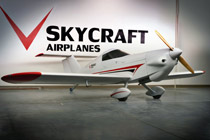 SkyCraft Airplanes of Provo, Utah, says its SD–1 Minisport single-seat tailwheel airplane is ready for FAA approval that will allow it to enter the Light Sport aircraft market. The $54,850 airplane comes ready to fly but options for an airframe recovery parachute and Mode S transponder can be added for an additional cost. Only one seat brings up the obvious question of how the owner learns to fly it. SkyCraft officials say a transition program using a two-seat aircraft with similar flying characteristics is in the works. It is said to fly similar to a Rans S–6 kitplane, the aircraft that was used for transition by a company official. There are four customers who have placed $2,000 deposits, half of which is refundable. The standard equipment for this 87-knot-cruise aircraft, powered by a 50-horsepower Hirth engine, includes a seven-inch Dynon SkyView display and night lighting. Company officials said in July that they expected final approval from the FAA by late August. A new hangar to be used as the factory has been acquired at Provo Municipal Airport. The first production run will be for 12 aircraft. —AKM
SkyCraft Airplanes of Provo, Utah, says its SD–1 Minisport single-seat tailwheel airplane is ready for FAA approval that will allow it to enter the Light Sport aircraft market. The $54,850 airplane comes ready to fly but options for an airframe recovery parachute and Mode S transponder can be added for an additional cost. Only one seat brings up the obvious question of how the owner learns to fly it. SkyCraft officials say a transition program using a two-seat aircraft with similar flying characteristics is in the works. It is said to fly similar to a Rans S–6 kitplane, the aircraft that was used for transition by a company official. There are four customers who have placed $2,000 deposits, half of which is refundable. The standard equipment for this 87-knot-cruise aircraft, powered by a 50-horsepower Hirth engine, includes a seven-inch Dynon SkyView display and night lighting. Company officials said in July that they expected final approval from the FAA by late August. A new hangar to be used as the factory has been acquired at Provo Municipal Airport. The first production run will be for 12 aircraft. —AKM
Preparing for 2015
Fantastic turnouts at the regional AOPA Fly-Ins this year have prompted the association to issue Request for Airport Proposals (RFP) for locations in 2015. Each 2014 fly-in has drawn more than 2,000 participants, more than 400 aircraft, and 900 vehicles. AOPA is looking for airports with a minimum of two runways, ample aircraft and automobile parking, event space, and a nearby reliever airport. “I could not be more excited about embarking on another year of engaging with members nd the public at some of the best GA airports in the country,” said AOPA President Mark Baker.
Progress report
The first production model of the Hondajet, meaning the one exactly like the customer will receive, made its first flight in June followed by a company-wide celebration.
Cessna’s first Citation X+ has been delivered. The jet is once again the fastest in all the land, flying at a maximum speed of Mach 0.935 and beating out the Gulfstream G650 that cruises at a mere Mach 0.925.
The $734,000 Cessna TTx (previously Columbia, previously Corvallis) now has a $49,500 anti-icing option that allows flight into known icing conditions.
Dassault Aviation will offer the 8X in 2016 featuring longer range and a larger cabin. It will be built in Bordeaux-Merignac, France. The company calls the aircraft its new “flagship.”
What’s coming?
Not in the air, but on land the British-built Bloodhound SSC (supersonic car) will attempt to go 1,000 mph with the help of both a jet engine and a rocket engine—that’s a mile every 3.6 seconds—to establish a new land speed record. It is under construction and will make the attempt in a few years. The team built a car that broke the sound barrier on land in 1999.
Solar Impulse 2 has completed several test flights and will circle the world on solar power alone, using recharged batteries for takeoff as well as daytime cruise, but drifting down to lower altitudes at night, from March to July 2015.
Breaking barriers
Supersonic jet plans supersized
By Jim Moore
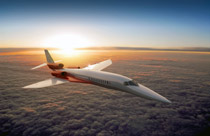 Aerion’s supersonic business jet concept has expanded to a fuselage length of 160 feet, with a maximum takeoff weight of 115,000 pounds.
Aerion’s supersonic business jet concept has expanded to a fuselage length of 160 feet, with a maximum takeoff weight of 115,000 pounds.
Aerion Corporation has extended the length—and the legs—of its supersonic business jet based on popular demand. The Reno company, working to bring a Mach 1.4 business jet to market, said new market research drove the decision to extend the dimensions of its concept jet first announced many years ago to afford more elbow room inside, add an engine, and extend the fuselage length to 160 feet.
The company is financing its own research and development effort, with an eye on bringing the jet to market in “or about” 2021.
Aerion was formed in 2002 from an engineering group that has been working for more than 20 years on the concept, and is currently selecting a powerplant for the three-engine configuration. A market survey completed in the first quarter of this year concluded that the demand exists for 600 aircraft purchases over 20 years for an aircraft with a range of at least 5,000 nautical miles, and owners would be willing to pay more than $100 million for it.
“That is the supersonic jet we are working to deliver,” CEO Doug Nichols said.
Aerion is not alone in the effort to break the business-jet sound barrier. A British firm led by Richard Lugg has been working for years to develop the SonicStar, which aims to shatter the sound barrier in near silence using engines that run on a massive electrical charge. The aircraft would eliminate the sonic boom that has limited supersonic flights over land.
Aerion has not announced a boom-mitigation strategy, and notes in its press announcement that the jet will have two cruise “sweet spots,” one at Mach 0.95 for “efficient cruise where supersonic flight is prohibited,” and another at Mach 1.4, with fuel efficiency at both speeds comparable to current business jets.
Email [email protected]


